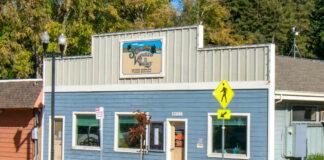
Last year I was introduced to the world of bonsai. Santa Cruz Bonsai Kai president Ron Anderson gave me a private tour of his personal bonsai collection at his home in Boulder Creek. Shortly afterwards, I attended the club’s yearly show held then in Scotts Valley. I arrived a bit late and the afternoon demonstration had already started. The sensei, meaning teacher, was in the process of turning a large 5-gallon overgrown juniper into a finished bonsai. The wiring had been done initiating the training of the branches to form a more pleasing shape and the root pruning was about to begin. All of us in the audience were mesmerized by the seemingly brutal treatment of the plant, but the results spoke for themselves. A beautiful, graceful juniper specimen displayed in a large, brown tray did all the talking.
Then the raffle began. Small finished bonsai specimens, starter plants and bonsai trays donated by club members to raise money all went to happy recipients as their ticket numbers were called. The final drawing was for the beautiful, graceful juniper just created by the sensei master. I could not believe my eyes when the winning number was announced. I was the winner. My specimen still lives happily displayed atop a large flat rock in my garden.
The show spans both a Saturday and a Sunday. On the Sunday afternoon last year, the sensei created another large bonsai of junipers tucked into pockets on a piece of lava rock. As luck would have it, a member of the Santa Cruz Bonsai Kai club, Marc Shaw, won the prize. Recently I had the opportunity to see how it’s doing along with the rest of his collection at his home. What a treat.
Marc has been interested in bonsai for 30 years. While working his way through college he found a job at a nursery in Southern California. His father had been a nurseryman so the love of plants runs in his family. He took a bonsai class with the owner of the nursery from John Naka, widely thought to be one of the first people in California to bring the ancient art form of bonsai to the U.S. Since then Marc has increased his collection and knowledge, but admits he has learned the most since joining the Santa Cruz Bonsai Kai club 10 years ago.
One of the reasons we all admire bonsai is how old they look. Some actually are hundreds of years old and handed down in families. Others just look very old as some techniques help further this illusion. Marc shared his method for increasing the size of the trunk of the plants. A thick, twisted trunk is usually only found on an old tree.
Marc has a small plot of land in his garden devoted to growing his future specimens. Underlaid with flooring material buried 6-inch deep he grows a plant for about two years in the ground. This way the roots can grow wide but not deep and helps the future tree trunk increase in girth. He has even knocked out a bonsai plant already growing in a shallow pot and transplanted it into the ground for a couple of years to change the look of the trunk.
Marc is especially drawn to developing bonsai called “root over rock” or Sekijoju. This simple but time-consuming technique mimics the way the upper roots of a tree grip a rock tightly and then are exposed by erosion over a period of years. He has many specimens in training. He starts them out by teasing the roots and spreading them over a beautiful rock. Collecting interesting rocks is part of the fun and Marc has a spot the family visits in Lake Nacimiento where he finds jaspar.
His oldest bonsai, a mugho pine, is 30 years old. Maybe someday it will rival the oldest bonsai specimens that are estimated to be about 800 years old as I found out on at www.bonsaitreegardener.net/5-oldest-bonsai-trees. In the meantime, he will continue to graft and air layer and train his specimens to perfection.
There are lots of stories and tips from members of the bonsai club and they are happy to share them with you. Don’t miss this year’s show at the Museum of Natural History in Santa Cruz March 23 and 24 to start your bonsai adventure.
– Jan Nelson, a landscape designer and California certified nursery professional, will answer questions about gardening in the Santa Cruz Mountains. E-mail her at ja******@*ol.com, or visit www.jannelsonlandscapedesign.com to view past columns and pictures.
IF YOU GO: Santa Cruz Bonsai Kai annual show
When: 10 a.m. to 5 p.m. Saturday and Sunday, March 23 and 24
Where: Museum of Natural History, 705 Front Street in Santa Cruz
Details: There will be a featured demonstration from 2 to 4 p.m. both days.












